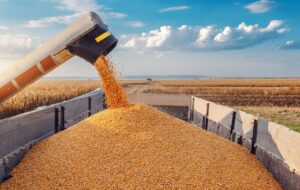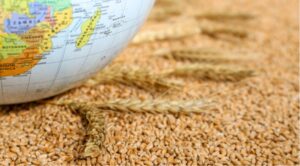
U.S. equipment is helping the State Border Guard Service of Ukraine and the Odesa Port Authority protect and maintain the Black Sea Humanitarian Corridor, which has so far shipped approximately 850 ships and 52 million tons of grain and cargo that will feed the world and support Ukraine’s economy, U.S. Ambassador to Ukraine Bridget Brink said.
“It’s great to be back in the thriving and courageous port city of Odesa, world-renowned for its rich cultural heritage. Even in the face of Russia’s daily attacks, Odesa stands firm on the Black Sea,” she said at the Black Sea Security Forum in Odesa.
The U.S. Ambassador said she regularly visits Odesa, meeting with local authorities, border guards, port workers and Odessans. These meetings allow her to form an idea of the problems facing the city and prove the determination of the residents to protect the city and its ports.

Ukraine in 2024-2025 marketing year (July-June) can export more than 60 million tons of grain and oilseed crops and products of their processing, which will allow it to remain among the world leaders of agricultural exports, Acting Minister of Agrarian Policy and Food of Ukraine Taras Vysotskyy said.
According to the Ministry of Agrarian Policy and Food, Ukraine can collect grain crops of the new harvest at the level of about 56 million tons, of which wheat – 21 million tons, barley – about 5 million tons, corn – 28.5 million tons.
Total exports of cereals are forecast at 43 million tons, in particular wheat – 15 million tons, barley – 2.5 million tons, corn – about 25 million tons.
The ministry expects oilseeds production at the level of 22 million tons, in particular rapeseed – 4 million tons, sunflower – about 13 million tons. Ukraine may harvest 5 million tons of soybeans, which will be a record in the history of Ukraine.
Exports of oilseeds and oilseed products are expected to exceed 17 million tons.
“After two years of full-scale war, Ukraine managed to equalize the market balance of production and export of major crops. (…) The current marketing year 2023/2024 Ukraine will end with the final balances of agricultural products at the average level, as it was until 2022. In the next marketing year, agro-exports will be over 60 million tons. And this shows that Ukraine remains a guarantor of world food security”, – summarized Acting Minister of Agro-Politics.

On June 12, Kyiv hosted the business forum “Grain. Pigs. Meat – 2024”, which brought together representatives of agribusiness, processing, supply, finance and investment, government agencies, experts and bloggers. We are grateful to the Armed Forces of Ukraine for this opportunity!
We are grateful to the guests, participants, partners and sponsors of the Forum from Kyiv, Chernihiv, Odesa, Mykolaiv, Lviv, Kharkiv and other cities and towns of Ukraine who attended the business forum “Grain. Pigs. Meat – 2024” and joined the discussion of crucial issues that help businesses move from confrontation to cooperation, provide new opportunities for scaling and development of entire sectors of the Ukrainian economy!
The Forum highlighted the issues that hinder the development of the Grain – Pigs – Meat value chain, held active discussions, proposed solutions and provided effective tools.

Forum participants learned about:
– The importance of developing industries that create added value in Ukraine’s economy in times of war, with raw material exports blocked, expensive logistics, and a cheap price for the raw material itself and its minimal added value
– The possibility of replacing grain exports with exports of meat and meat products, which are high value-added goods.
– The state and prospects of the pig and meat industry in Ukraine during and after the war.
– The next stages of implementation of the New Pig Breeding of Ukraine program, which envisages a fourfold increase in the number of pigs, from 6 to 12 billion euros of added value.
– Possibility of eradicating ASF in Ukraine through vaccine prevention, lifting the stamping out in industrial pig production and unblocking pork exports.
– Establishment of an international consortium to support ASF control measures in Ukraine and Europe.
– Adaptation of pig production in Ukraine to a possible decline in pig prices due to overproduction in the absence of pork exports.
– Investment opportunities for the meat industry, pig production and farmers.
– Newest and digital technologies for pig production and meat processing.
– The Family Pig Farms social project, which will help war veterans start a successful pig farming business.
– Opportunities to obtain additional funding, grants, and investment.
– Training of highly qualified personnel for meat industry enterprises.
– Implementation of a mechanism for cooperation between producers and processors to protect profitability throughout the chain.
We call for cooperation for the development of Ukraine and believe in Ukrainians who, even in the most difficult times, do their best to rebuild our country. Only together we can make the Ukrainian agro-industrial complex stronger, more sustainable and competitive in the global market!

Global grain production in the 2024-2025 marketing year (MY, July-June) will increase by 1% compared to the previous season and amount to 2312 million tons due to higher yields of wheat, barley and sorghum, which will compensate for the decline in corn production, the International Grains Council (IGC) said in a report on Thursday.
At the same time, grain consumption will increase, and end-of-season stocks are expected to fall to a ten-year low, including in major exporters.
According to the forecasts, the volume of contracted grain trade in 2024/25 MY will increase by 4% and reach 416 mln tonnes. At the same time, the demand for global consumption will amount to 2320 mln tonnes, and carry-over stocks will be 580 mln tonnes.
In 2024/25, the global soybean production is expected to reach the maximum of 414 mln tonnes. The main demand for soybean products in the upcoming season will come from the world’s leading buyers – the USA, Brazil and Argentina. At the same time, carry-over stocks continue to accumulate. The trade in soybeans in October-September will intensify and increase by 2%, reaching a new high, according to IGC.
Speaking about other oilseeds, IGC drew attention to the expected significant global production of rapeseed/canola against the background of almost unchanged sunflower production, which will be similar to last year’s volume.
According to IGC forecasts, global rice production in 2024/25 MY will reach a record peak and grow by 2%, driven by increased production in major exporting countries, particularly in South Asia. Rice consumption will increase due to population growth, while stocks may increase due to accumulation in India. Trade is likely to decline in January-December 2025 amid rising supplies to Africa and lower demand from Asian importers, particularly Indonesia.
The IGC forecasts a 5% decline in demand for lentils and beans in January-December 2024 to 21.2 mln tons.
The International Grains Council also drew attention to the temporary abolition of tariffs on imports of raw rice, brown and white rice to Brazil until the end of 2024, which aims to mitigate the effects of recent rains and floods in southern Brazil. In addition, IMG members noted recent changes in India’s pulses import policy.

World grain production in 2023-2024 will be 1.2% higher than a year earlier, amounting to 2.846 billion tons, taking into account the increase in barley, rice and sorghum production, FAO (the UN Food and Agriculture Organization) predicts.
According to its review, global production of corn and wheat will decline, while barley, rice and sorghum production will increase. In addition, the recent unfavorable weather conditions in the Black Sea region are likely to lead to a decline in global wheat production, but this possibility is not yet reflected in the forecast.
At the same time, global grain stocks are likely to increase by 1.5% compared to the initial level and reach a record high of 897 million tons. Corn, barley, sorghum, and rice stocks are expected to increase, while wheat stocks may decline. The global stocks-to-use ratio is likely to remain at 30.9%.
In addition, the FAO revised its forecast for global cereal consumption in 2024-2025 by 0.5% to a new record level of 2.851 billion tons, which it explained by an increase in food consumption, especially rice.
Global grain trade will decline by 1.3% compared to the previous year to 481 million tons, due to lower prospects for corn trade. International trade in rice is expected to grow strongly, FAO predicts.

As of May 24, Ukraine exported 45.402 mln tonnes of grains and pulses since the beginning of 2023/24 marketing year (MY, September 2023 – August 2024), of which 3.997 mln tonnes were shipped in May, the press service of the Ministry of Agrarian Policy of Ukraine reported, citing the State Customs Service.
According to the report, as of the same date last year, the total shipments amounted to 44.593 mln tons, including 2.707 mln tons in May.
In terms of crops, since the beginning of the current season, 16.949 million tons of wheat have been exported (in May, the figure was 1.163 million tons), 2.363 million tons of barley (161 thousand tons), 1.4 thousand tons of rye (0.2 thousand tons), 25.563 million tons of corn (2.662 million tons).
Total exports of Ukrainian flour as of May 24 are significantly lower than last year’s figure (138.9 thousand tons) and are estimated at 90.9 thousand tons (4.3 thousand tons in May), including 85.9 thousand tons of wheat (3.9 thousand tons).